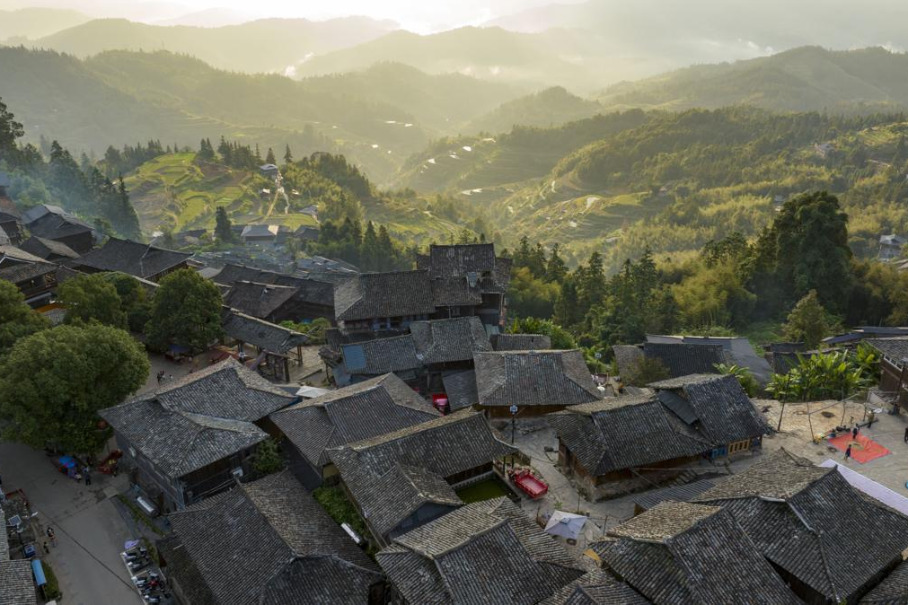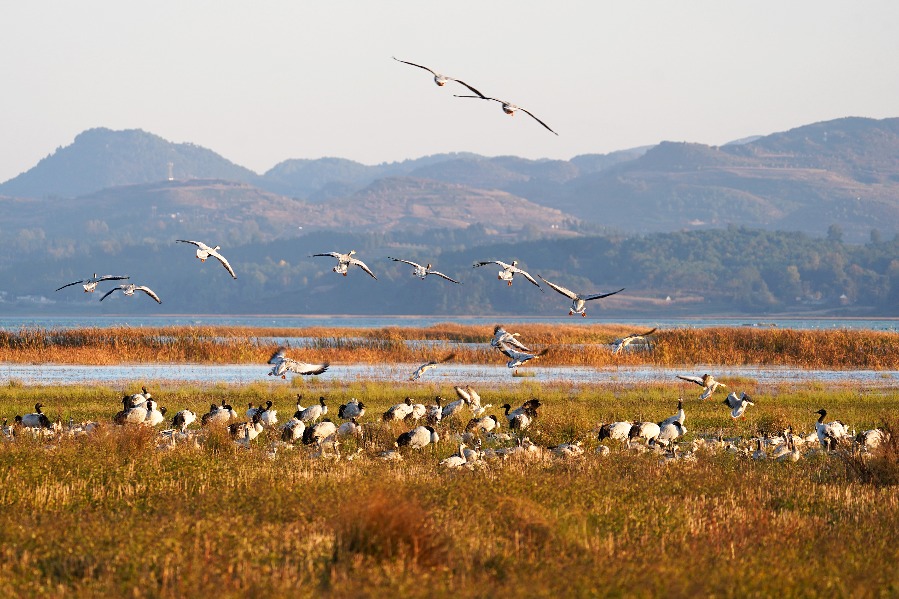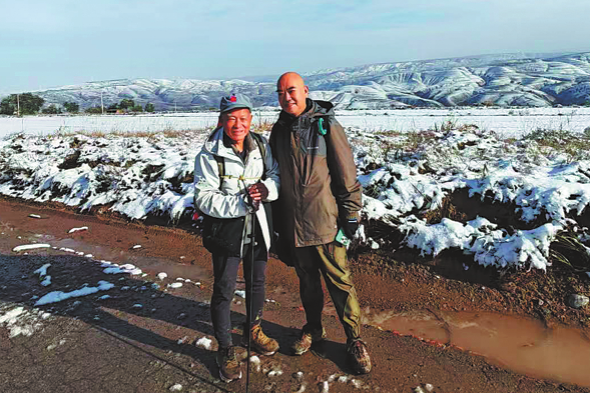China's largest desert transforms into green development powerhouse for Xinjiang


URUMQI -- Once known as the "sea of death," the Taklimakan Desert, the world's second-largest shifting sand desert, has become a driving force for green development in Northwest China's Xinjiang Uygur autonomous region.
In recent years, photovoltaic stations have been constructed, and large plantations of vegetation such as roses and cistanche have emerged on the outskirts of this vast desert, equivalent in size to Malaysia.
This transformation has not only attracted tourism but also positioned the desert as a flourishing center of sustainable development.
Green initiatives in the desert
Under the sun's rays, rows of PV panels that generate electricity resemble a shimmering blue ocean.
Tian Juxiong, head of a power station in Lop county, Hotan prefecture, regularly inspects these power generation systems and monitors their daily operations on the control center's screen.
"The southern part of the Taklimakan Desert benefits from low precipitation and ample sunshine, resulting in up to 1,600 hours of electricity generation each year," Tian said.
Operated by the State Power Investment Corporation, this station boasts a total installed capacity of 200 megawatts, producing 360 million kWh of electricity annually.
The station can meet the residential electricity needs of the 25.9 million residents of Xinjiang for around 10 days. Every year, it saves approximately 110,000 tonnes of standard coal and reduces 330,000 tonnes of carbon dioxide and 1,300 tonnes of nitrogen dioxide.
The project is also equipped with an energy storage system with a capacity of 80,000 kWh.
"In rainy conditions when the station cannot generate electricity, the storage facility acts as a power bank, providing energy for approximately two hours," Tian said.
According to Yu Zhongping, a researcher with State Grid's Xinjiang branch, most PV and wind power stations in southern Xinjiang are equipped with storage systems to ensure a stable supply of renewable energy.
In Kuqa City, located on the northwestern edge of the Taklimakan, a green hydrogen project is set to commence operations, with an expected production capacity of 20,000 tonnes upon completion.
Solar power replaces fossil fuels in generating hydrogen, said Cao Jie, vice manager of Sinopec Tahe Refining and Chemical Company.
According to a document released by the National Development and Reform Commission, China aims to accelerate the construction of large-scale wind and solar power bases in desert regions, develop hydropower infrastructure, and explore and utilize biomass, geothermal, and ocean energy during the 14th Five-Year Plan period (2021-25).
By May, the total installed capacity for renewable energy in southern Xinjiang had surpassed 8,400 megawatts, and an additional 8,259 megawatts of new energy facilities are currently under construction, according to Ding Biwei, who is responsible for grid connection of new energy at State Grid's Xinjiang branch.
"As power grids are gradually being interconnected to encircle the Tarim Basin, the electricity generated from new energy sources not only injects green vitality into southern Xinjiang but also contributes to achieving carbon peak and carbon neutrality," Ding said.
Blossoming cash crops, windbreaks
Zorigul Yakhup and many other farmers in Oytograk Township, Yutian County, Hotan, find themselves immersed in a bustling atmosphere as they diligently pluck roses of various breeds amidst the sprawling 667-hectare base of Yutian Guimi Bio-technology Co., Ltd.
"Every May, when the roses bloom, I come here to pick them. I can pick 40 or 50 kg a day," said Zorigul Yakhup.
These vibrant blossoms are harvested three times a year -- in May, June, and September -- in Yutian, located on the southern edge of the Taklimakan Desert. It is her third year engaging in this activity, and she earned about 12,000 yuan ($1,684) during the three-month picking period.
In addition to working for Guimi, Zorigul Yakhup also plants roses on her own farmland, with half of the strains being Damask roses, which are sold to manufacturing enterprises at a price of 20 yuan per kg.
Liu Zhiyong, vice general manager of Guimi, said that since 2012, the company has invested nearly 100 million yuan in planting roses and creating windbreaks. These windbreaks consist of red willow, saxaul, and poplar trees, which serve to protect the flowers.
"We are no longer afraid of sandstorms as the windbreaks stand tall," he said, adding that during the first three years of the business, sandstorms destroyed nearly 40 percent of the roses due to the inadequate height of the windbreaks.
Guimi has also implemented over 2,000 km of water-saving drip irrigation belts to nurture its plants. Despite Yutian's location on the desert margin, its underground water resources are utilized effectively. Last year, the plantation base produced over 300 tonnes of roses.
Around 20 km away from the base, Guimi's roses are processed into sauces, hydrolates, and other products in an industrial park.
Liu said that Guimi has established an industrial chain encompassing mass-scale planting, production, manufacturing, and sales, which helps more than 10,000 nearby farmers increase their income each year.
Yutian accounts for approximately 93 percent of the 3,453 hectares of rose plantations in Hotan, and the yearly income from roses in the county is 90,000 yuan per hectare, according to the prefecture's agriculture and rural affairs bureau.
Apart from the profitable rose cultivation, the windbreaking saxaul tree serves both ecological and economic purposes. Since 1998, the plant has been grown on a large scale in the desert county of Qiemo, Bayingolin Mongolian autonomous prefecture, as part of an afforestation project to prevent and control desertification.
Around 2003, cistanche, a crop known as the "ginseng of the desert," was introduced to the county, parasitizing the roots of the saxaul tree. More and more enterprises started investing in this plant to produce traditional Chinese herbal medicine.
The utilization of the Taklimakan Desert promotes the development of agriculture, manufacturing, and environmental protection.
During the 13th Five-Year Plan period (2016-20), Xinjiang restored 1.89 million hectares of desertified land, effectively curbing the trend of land desertification, according to the region's forestry and grassland bureau.
"Roses have not only filled our pockets with cash but also added sweetness to our lives," said Zorigul Yakhup.
New tourist attraction
Alim Imin skillfully maneuvers a desert motorcycle in the picturesque desert spot of Dawakun, located in Kashgar Prefecture, offering visitors an exhilarating experience of riding freely on the sandy terrain.
"In the peak season, I can transport up to 20 people a day, earning a monthly salary of over 4,000 yuan through this business," he said.
Situated on the southwest edge of the Taklimakan Desert, Dawakun is renowned for its unique landscape, featuring a lake embedded in the sand. According to Ye Ming, the manager of Dawakun, the scenic spot has recently hosted more than 5,000 tourists a day on weekends.
Jiang Wanwen, vice secretary general of the China Adventure Association, said that over 400 million people participate in outdoor sports in China, and Xinjiang boasts abundant resources for outdoor travel.
This year, Xinjiang launched an express rail loop line for tourism around the Taklimakan Desert. Typically, tourists visit scenic spots during the day and spend the night on the train.
A single journey lasts for 11 days. There are 18 such trips expected for this year, with each accommodating up to 500 tourists. With more than 1,200 km of highways across the Taklimakan Desert, travelers also have the option of embarking on a road trip.
During this year's May Day holiday, Xinjiang received a total of 8.05 million tourists, representing a remarkable year-on-year increase of 140.8 percent.
Tourism revenue reached 6.03 billion yuan, marking a substantial growth of 192.2 percent compared to the previous year, according to the region's culture and tourism department.
Apart from outdoor adventures, the cultural and historical significance of the desert is being unearthed.
Near a relic in Hotan County, the Yotkan cultural scenic spot has been established, featuring antique architecture and offering various activities such as performing arts, culinary experiences, and exhibitions of intangible cultural heritage.
Inside Yotkan, actors dressed as ancient businessmen sing and dance, captivating passing tourists. Some travelers don traditional Hanfu garments and eagerly request photos with the performers.
Mu Zhenjie opened a costume rental store at Yotkan, providing tourists with traditional clothing from different ethnic groups along with makeup services.
"I hope tourists can don our costumes and experience a sense of 'time travel'," he said.
- China opens draft regulations on data protection to public consultation
- Veteran French physicist elected to Chinese Academy of Sciences
- Former Polish deputy PM praises China's economic rise, growing influence
- HK powers the nation's equestrian development
- Forum hailed for promoting Global South modernization
- Wushu needs more events in GBA, coaches in Macao say




































